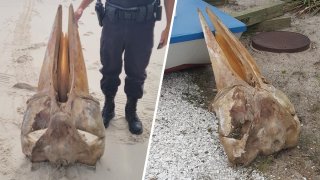
A giant skull found Monday on an Ocean County beach was a mystery at first. But, it turns out, it had likely been there all along.
The New Jersey Department of Environmental Protection discovered the skull and lower jaw of a Minke Whale at Island Beach State Park.
After a brief Twitter guessing game, experts said they believe it belongs to a Minke Whale that was buried on the beach in June 2020.
Get Philly local news, weather forecasts, sports and entertainment stories to your inbox. Sign up for NBC Philadelphia newsletters.
Bob Schoelkopf, director of the Marine Mammal Stranding Center, said the skull showed up in a similar location to where a Minke Whale was buried in the park last summer.
"The fact that it washed back up is not unusual," Schoelkopf said. "This is a common thing to happen when we bury animals on the beach."
He said parts from an animal buried on the beach become uncovered about once a year.
Local
Breaking news and the stories that matter to your neighborhood.
It's common to bury whales on the beaches and parks where they are stranded because their size makes it difficult and expensive to transport them to another burial site, Schoelkopf said. Over 100 whales have been buried across the state.
Minke Whales weigh up to approximately 20,000 pounds and can be as long as 35 feet, according to the National Oceanic and Atmospheric Administration.
"When you have an animal that weighs that much, you just don't pick it up and carry it some place," Schoelkopf said.
He added that the animals are buried as deep as possible depending on the characteristics of the beach.
Whales are typically buried at least six feet deep, so there must be a big storm or strong surf to bring one close to the surface, Rutgers University Ecology and Evolution Ph.D. candidate and lead researcher for Gotham Wale Danielle Brown Brown said.
That's exactly what happened on Monday as heavy surf and winds over the weekend led the skull to be unearthed, Brown said.
She added that there has been an unusual mortality event of Minke Whales in recent years which have led to numerous strandings along the East Coast.
If you see part of an animal on the beach, leave it where it is and report it to the Department of Environmental Protection or the Marine Mammal Stranding Center, Schoelkopf and Brown advised.



